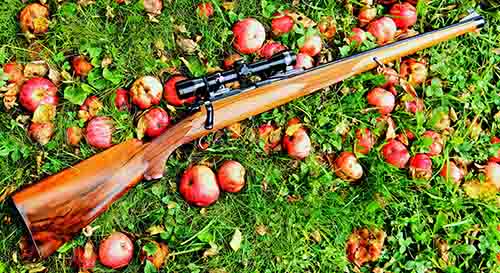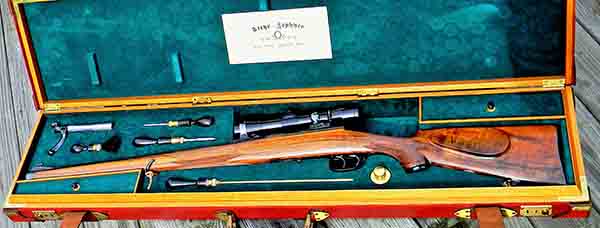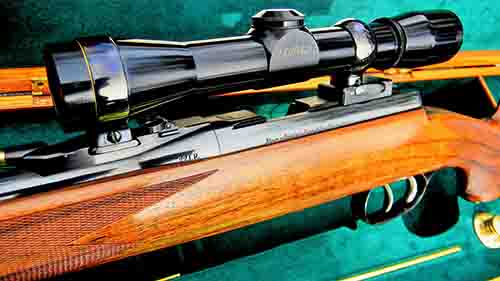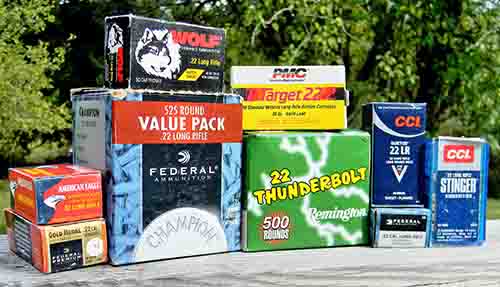
Manufactured from 1955 to 1971, I’d only occasionally heard of the little brother to the classic Mannlicher-Schoenauer, known as the Steyr Zephyr. When my good friend from Australia asked if he could have a custom Zephyr shipped to me in an equally custom hard presentation case, I said that would be OK…but could I shoot it? The plan was for me to bring it out on my next trip, with all the proper importation documents of course. Hesitantly, I said yes, but only if I could fondle it some from time to time, and shoot it. When he agreed to that, I agreed to have the seller send it my way.
Chapter 1: Oh My…
Click to LOAD DATA SHEET
When my local dealer received the box, I eagerly headed to town to sign all the papers and bring the new toy home. After arriving in the store and completing the necessary paperwork, the clerk brought out a box. As I tried to pick it up, I let out a grunt! The shipping weight was almost 30 lbs.! Ok, subtract two-pounds for the cardboard box, and we’re still looking at 28 lbs. for the cased rifle. I thought this was a light, svelte .22 LR plinker? Knowing it was a strong four-figure firearm ($$$$), I didn’t want to make a scene at the store, so just grabbed the box and headed for home to inspect what this heavy package could possibly contain.
Carefully undoing the straps, I finally flicked open the brass hasps and opened the heavy hinged lid. Inside laid a most lovely rifle with a deep high polish, jet black metal barrel and action, married to a golden full Mannlicher stock, nestled in a fitted case of oak and hunter green felt. There was a fitted recess for the bolt, two different screwdrivers, and a brass oil can, a tufted natural brush to chase dust away, a solid brass cleaning rod, and two nifty lidded compartments for small sundries in each opposing corner. I stood and just looked at it for a while, feeling I needed to ask permission to pick it up, but my friend had already given me his consent.
The Steyr Zephyr sported a 20” barrel and was less than40” long overall. It wore a proportionally sized, Leupold 4x Compact model scope, most appropriate for such a rifle, held in fine quick release scope rings with the front one grabbing around the front objective....
I could tell right away that this was not in factory condition- it was far superior to that. As the petite carbine weighed at most 6.5 lbs., which put the weight of the custom, fitted case at around 23 lbs.! Manufactured by Huey Gun Cases, out of Kansas, USA (www.hueycases.com), it truly presents and protects the finest firearms made.

Paperwork later sent to me told the interesting history of the rifle. Originally made in 1968, starting in 1990, Florida gunsmith Henry Cheatham worked on it for a year to restock the rifle with a full stock of New Zealand English walnut, install a muzzle cap flush with the end of the barrel, a Biesen trap butte plate, and he made a traditional spoon-type bolt handle for it. He also added a short quarter rib for a new rear sight and reworked the firing pin for a new safety. A total of 163 hours were spent on the stock, and 53 hours on the metalwork- including his own claw-type scope mounts and 10 hours to polish and blue. The craftsmanship on the rifle is awesome, and please note that Mr. Cheatham was 92 years old when he completed the rifle in 1991!
I wiped it down with an oiled cotton rag and had to remove six of my own personal rifles from my safe in order to put the fully cased Zephyr in my gun safe. Actually, I’m somewhat uncomfortable being responsible for such a nice package and look forward to the day I can hand it over to its rightful owner. But in the back of my mind I kept wondering… can it shoot?

Chapter 2: Range Day
Amazingly, I was able to gather up nine types of .22 LR ammo, which nowadays is almost an impossible thing to do. Yes, two to three years after re-electing a very liberal president to a second term, ammunition availability, as well as powder and primers, is still a hit or miss proposition. I headed to the range, taking the Zephyr in its hard case, but was fearful on my way that I might crash and burn and have to explain the loss of his...
custom rifle to my friend. I went in the middle of the afternoon during an off day, hoping no one else would be at the range. I didn’t want to advertise what I had inside that long, heavy case.
Fortunately, I didn’t crash and burn… and no one else was at the range the entire time I was shooting. As the barrel was spotlessly clean inside, I first fired a dozen or so rounds to get the rifle sighted in to be 1.6” high at 50 yards on my new light green targets, resulting in many small groups landing in the open circle.
With a bright clear day, it was interesting to see the relatively slow lead bullets rise and then fall through the Leupold scope on their way to the aiming point. My new CED- Competitive Edge Dynamics M2 chronograph was used to obtain velocities. Its very large display screen happily replaces my old unit, which was always hard to read. I was surprised how well CCI Stinger ammo shot, at 1,620 fps, and produced 5-shot group averages of only 0.63”, with its copper plated 32 grain hollow point bullet. This would be great for small game, or even up to foxes.

Federal’s American Eagle plated 38 gr HPs delivered 0.89” averages at 1,229 fps, while the Champion HP hit virtually the same speed but was not as well liked by the Steyr, for right at 1” groups. Their slightly heavier 40 gr solid was actually faster at 1,253 and shot better in the Zephyr, delivering a smaller average of 0.80”. I was surprised that Federal Gold Medal Match only produced groups just slightly smaller,measuring 0.76”.
Some PMC Target ammo with a 40 grain solid was pretty slow at only 984 fps but delivered nice round and consistent 0.67” five-shot group averages. Physically, the lead bullet in the Wolf Match Target ammo was extremely uniform looking and free of the many numerous dents and dings most of the other .22 ammo displayed. Its accuracy was excellent with an average group size of only 0.63” for three 5-shot groups at the stated 50 yards.
I was surprised that the economy 525 round, bulk-pack of the Remington Thunderbolts with their solid 40 grain lead bullet was respectable at 1,182 fps and consistently...
produced nice round groups averaging 0.68”. These only cost around $25 for the cubed carton. Proportionally, most of the ammo I tested cost far more that this bulk Remington “plinking” ammunition, a very pleasant surprise.
Chapter 3: Quite the Surprise!

If you were counting, so far only eight types of ammo have been covered, but I lead by saying I tested the only nine I could get my hands on. The last was one I already had and just happened to toss into my shooting box at the last moment. The relatively new CCI Quiet .22 feature a 40 grain unplated lead bullet and uses NO powder, only primer to propel the bullet to just under 700 fps!
It’s meant for very low-level noise plinking, and not having powder in the case, I had very low expectations. This however, was what I came to find. Shooting it as my last test ammo at 50 yards, it was painful to see it coast to the target, and watch it fall and impact about 2” below the other ammo. What good can this be, I thought… if it hits so far from the regular rounds?
There was far more drop than I could deal with in the field, and the wind tended to push it around quite a bit more, resulting in very unimpressive groups, especially in comparison to some of the above better performing, full power rounds. Perhaps, I thought, I am expecting too much from this powderless round. About to write it off and not even include in my test results, I glanced at a target I had also thrown up at only 25 yards to help first get me on the paper. Oh, what the heck… let’s see how it does at 25.
My first shot at a sighter portion on the paper strikes TO THE POINT OF AIM… but not of the fine crosshair. The Quiet .22s were striking exactly at the point of the lower Duplex on the bottom reticle on the Leupold 4x Compact scope. Thinking it might be a fluke, I fired one more round, and the holes touched. With a smile on my face, I keep loading up the 5-round magazine and fire one, and two, and then a third group at my targets. Nearly every group had all five rounds touching- almost a one-hole group!
When measured, I was elated to...
have a fifteen round average group size of only 0.40” at 25 yards! With that level of precision, and air rifle speeds, but a heavier 40 grain bullet, accurate head shots on squirrels, rabbits or pests would be easy out to maybe even 30 or 35 yards.
While centerfires often show a distinct preference for a certain powder or two with a given bullet, so, too, can a .22 LR prefer one ammo brand over another.
This is good reason to try several ammo types in your .22 plinker, or a fine elegant custom rifle like my friend’s Steyr Zephyr. Sadly, it will stay in my safe until the time that it will fly with me to Australia. For a while, I got to play with it for a bit. This almost 50 year old rifle is too nice for me to casually plink with. I’ll leave that task to him, later, down under.